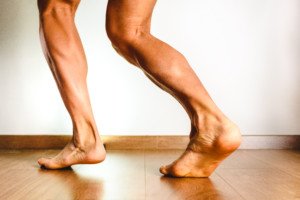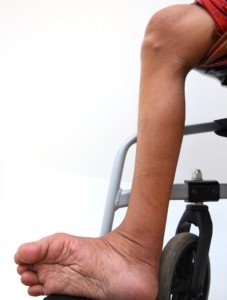
Here is your FINAL article on the calf dent that you think is a sign of ALS muscle atrophy.
Do calf dents have you terrified you have ALS because you think this is how muscle atrophy should look?
Finding this article means that you are most likely deep within the agony of ALS fear originating from twitching muscles and/or dents in your legs.
You’ve been spending an lot of time inspecting your legs, particularly calves, for muscle atrophy.
Muscle twitching aside, you have discovered dents in one of your calves, or maybe just one dent there, and are wondering why the other calf doesn’t have the same dent or groove.

Could this be a sign of muscle atrophy in the “odd” calf that has the dent?
“No, no, and no,” says Marc I. Leavey, MD, a primary care physician with 40+ years of experience.
Dr. Leavey continues, “The dents are the definition from the hypertrophied muscles.”
Hypertrophy means the opposite of atrophy: muscle enlargement. If you’re into physique development, you’ll want dents.
You’ll know that these are the result of developed or trained muscle in combination with low body fat in that area.
Have you ever seen a person who has atrophied legs for real?
This would be someone who’s been paralyzed for so long that their muscles have wasted away.
Ever see them in shorts? No dents. That’s because the muscles have become putty.

This atrophied leg is smooth and dent-free. Shutterstock/podsy

Muscle atrophy but no grooves. Shutterstock/Somchai photo
Dr. Leavey says, “Someone in a wheelchair with paralyzed legs has nice, smooth, albeit useless, legs.” Yes, “smooth.”
What’s really happening is that your mind is playing tricks on you, all because you probably googled muscle twitching.
Though muscle atrophy is the result of ALS, a dent in a calf is not a hallmark sign of muscle atrophy.
Let’s go more extreme about this: bodybuilding. “Bodybuilders build muscles, and those muscles produce the physique and definition that is sought,” says Dr. Leavey.
“If you tried to build a clay model of a lower leg, making each muscle the desired size and shape, you would see that there are grooves and separations between these well-developed muscles.
“It is that very desired result that produces the dents that are seen in such individuals.”
But what if you’re not a bodybuilder?
“Whether bodybuilder or not, we all have the same muscles, in the same places,” says Dr. Leavey.
“Some are just shapelier than others. That means that a well-developed calf muscle may show good definition in a non-bodybuilder, yielding the same dent as the more active individual.
“Perhaps walking on stiletto heels caused a particular muscle to hypertrophy.
“For the most part, such muscle definition yielding ‘dents’ is not pathological.
“If there are any doubts, or if a change develops acutely, though, you should seek medical attention.”
I used to be a certified personal trainer for a major health club chain.
So I know a lot about muscles and body composition.
If you’ve lost body fat recently, and especially if you’ve been exercising more, and you’ve been noticing the development of a dent or two in your calves…this is the result of the fat loss and exercise!
Less fat between your skin and muscles, and firmer, more trained muscles mean increased definition, a.k.a. dents!
Stop worrying! It’s not atrophy! It’s not muscle wasting – it’s muscle growth!
Here is how this whole frightening process develops:
Your lower leg muscle begins twitching. You google this. On the first page of search results are links to ALS information.
Panic ensues. The twitching “spreads.” You read about muscle weakness and atrophy. You begin examining your legs.
Invariably, you discover dents that you swear were never there before.
Your mind begins playing tricks on you. New dents appear overnight.
From a Fitness Expert:
Listen to me: Calf dents are normal. It’s called muscle definition.
If you don’t believe me, open a fitness or bodybuilding magazine and look at the legs. They are full of dents.
In fact, check out magazines on running or soccer. People with low body fat, and especially with toned muscles from running, athletics or weight exercises, will have lower leg dents.
Bodybuilders, physique and figure competitors strive for calf dents as well as grooves everywhere else.

How many dents or grooves can you count in this bodybuilder? Shutterstock/Jasminko Ibrakovic
In fact, their jargon for calf dents is striations, cuts and rips. I’ve had personal training clients who, upon discovering dents in their legs and arms, became ecstatic and pointed them out to me:
“Look! I never had this before!” IT’S MUSCLE DEFINITION.
And in your case, you just never noticed it before. Muscle definition fluctuates.
So even if you know you never had a calf dent before, this is no cause for alarm.
Because muscle definition is variable over time, due to fluctuating eating habits, fluctuating exercise habits, and other factors that affect body composition and appearance — including water retention.
If you want to know what muscle atrophy REALLY looks like, look at the legs of someone in a wheelchair.
If anything, their atrophied calves had NO dents! Atrophied muscle that has turned flaccid and limp is dentless, because it’s not firm enough to show definition.
Anxiety causes twitching to rapidly spread, and it causes you to discover things that have always been there. So re-read this article!

Dr. Leavey was formerly with Mercy Medical Center in Baltimore, MD, where his focus was primary care and internal medicine. He has a blog, STRING OF MEDICAL PEARLS.
 Lorra Garrick has been covering medical, fitness and cybersecurity topics for many years, having written thousands of articles for print magazines and websites, including as a ghostwriter. She’s also a former ACE-certified personal trainer.
Lorra Garrick has been covering medical, fitness and cybersecurity topics for many years, having written thousands of articles for print magazines and websites, including as a ghostwriter. She’s also a former ACE-certified personal trainer.









































